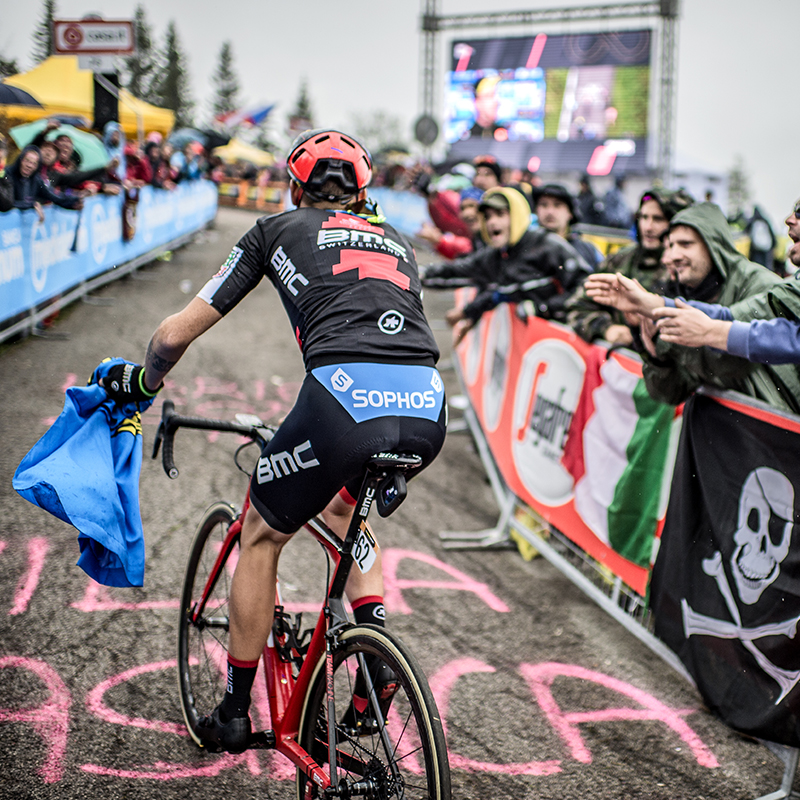Watching Fizik and Team Sky’s Geraint Thomas take victory on Alpe d’Huez at this year’s Tour de France, or the world’s best riders facing the mountain stages in the Vuelta a España.
You might think they’re from a different cycling planet. But there are many techniques sportive and granfondo riders can learn from Thomas and his fellow world-class climbers – we’re talking Team Sky’s Chris Froome, Movistar Team’s Alejandro Valverde, Mikel Landa and Nairo Quintana, and AG2R La Mondiale’s Romain Bardet.
SIT OR STAND?
Let’s start with the age-old question of whether to sit or stand.
“For me it’s all about the steepness and length of the climb, the shallower the climb, the faster you go, so you don’t need to stand. It’s also more aerodynamic when you sit. If it’s steep, you can enjoy a brief advantage by standing out the pedals.”
Marco Pinotti – BMC Racing Team’s sports scientist
Science supports Pinotti with Professor Ernst Hansen showing that road cyclists were more efficient when remaining seated until the gradient hit 10%. Then, with red blood cells screaming for more oxygen, standing became more efficient. In fact, during short, all-out bursts, peak power output has been measured at 25% greater when standing compared to sitting. Then again, at shallower gradients of around 4%, ascending at 19km/hr requires 10% less oxygen seated than completing the same distance at the same speed when standing.
Some riders like Thomas (approx 70kg) who are known for remaining in the saddle, attribute their style to growing up racing fixed-gear track bikes where you rarely leave the saddle. However, natural born climber Quintana (approx 58kg), who learnt his technique in the mountains of Colombia, is often out of the saddle. As a broad guide heavier riders benefit from staying in their saddle longer to bear their higher weight; lighter riders can afford to dance out of the saddle longer. Ultimately, as you rack up the miles, you naturally find the mix that best suits you.
POWER & WEIGHT
That issue of weight not only impacts positional choice but also power output. Once the gradient tips over 4-5%, your power-to-weight ratio becomes more important than absolute power. Imagine you’re a 85kg rider and your absolute power is 300 watts. On the flat, you’re more powerful than a 70kg rider whose absolute power is 270 watts. However, on climbs, the lighter rider is faster because their power-to-weight ratio is higher: 3.86w/kg compared to 3.53w/kg. Clearly, weight loss helps here, so aiming for a 1lb loss per week by ‘simply’ expending more calories than you consume.
INTERVALS
Interval hill sets will also burn a huge number of calories, while acclimatising you to the pain of climbs. Mikel Landa’s known for favoring a 15-minute ascent in his Basque homeland that’s not too steep, but can be conquered by riding at a moderate pace for 11mins before riding at threshold for 4mins. He’ll do this four or five times in a 5hr ride to develop the ability to accelerate and recover. You can start by doing this once in a 1hr ride and building up to three efforts in a 3hr ride. Landa is also keen on high-torque, low-cadence work (around 50-60rpm) to build power – it’s a technique you can practise.
HANDS
Be aware of hand position. Looking again at Landa, he’ll vary climbing on the drops, tops and hoods. The drops are faster and often used for attacking; tops are when it’s tougher; and hoods are for easier climbing at moderate pace. Try mixing and matching to suit what you feel is more effective.
Climbing efficiently and quickly will transform your sportive riding. Ultimately, the best way to improve your climbing is to just get out on your bike and ride as many hills as you can.












